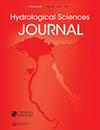基于物理和人工智能的降雨-径流-泥沙过程建模混合模型
IF 2.5
3区 环境科学与生态学
Q2 WATER RESOURCES
Hydrological Sciences Journal-Journal Des Sciences Hydrologiques
Pub Date : 2023-07-27
DOI:10.1080/02626667.2023.2241850
引用次数: 1
摘要
摘要:本研究评估了水文工程中心-水文建模系统(HEC-HMS)、Hydrologiska byr本文章由计算机程序翻译,如有差异,请以英文原文为准。
Physical and artificial intelligence-based hybrid models for rainfall–runoff–sediment process modelling
ABSTRACT This study evaluates the performance of the Hydrologic Engineering Center-Hydrologic Modelling System (HEC-HMS), Hydrologiska Byråns Vattenbalansavdelning (HBV), Soil and Water Assessment Tool (SWAT), feedforward neural network (FFNN), adaptive neuro-fuzzy inference system (ANFIS), support vector regression (SVR) and multilinear regression (MLR) for modelling the rainfall–runoff–sediment process in Katar catchment, Ethiopia. Afterward, neural network ensemble (NE), weighted average ensemble (WE) and simple average ensemble (SE) techniques were developed to improve the performance of single models. The performance of the models was evaluated using Nash-Sutcliffe efficiency (NSE), root mean square error (RMSE) and mean absolute error (MAE). The results show that the ANFIS model outperformed the other single models for rainfall–runoff–sediment modelling. Moreover, the integration of artificial intelligence and physically-based models resulted in improved performance, with the NE technique demonstrating better accuracy by improving individual models by 5.8–27.6% for rainfall–runoff and 3.59–37.9% for suspended sediment load modelling in the validation phase.
求助全文
通过发布文献求助,成功后即可免费获取论文全文。
去求助
来源期刊
CiteScore
6.60
自引率
11.40%
发文量
144
审稿时长
9.8 months
期刊介绍:
Hydrological Sciences Journal is an international journal focused on hydrology and the relationship of water to atmospheric processes and climate.
Hydrological Sciences Journal is the official journal of the International Association of Hydrological Sciences (IAHS).
Hydrological Sciences Journal aims to provide a forum for original papers and for the exchange of information and views on significant developments in hydrology worldwide on subjects including:
Hydrological cycle and processes
Surface water
Groundwater
Water resource systems and management
Geographical factors
Earth and atmospheric processes
Hydrological extremes and their impact
Hydrological Sciences Journal offers a variety of formats for paper submission, including original articles, scientific notes, discussions, and rapid communications.

 求助内容:
求助内容: 应助结果提醒方式:
应助结果提醒方式:


